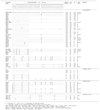Evaluation of global clustering patterns and strain variation over an extended ORF26 gene locus from Kaposi's sarcoma herpesvirus
- PMID: 17690010
- PMCID: PMC2043355
- DOI: 10.1016/j.jcv.2007.06.013
Evaluation of global clustering patterns and strain variation over an extended ORF26 gene locus from Kaposi's sarcoma herpesvirus
Abstract
Background: Small 233-bp or 330-bp DNA fragments of the ORF26 gene of human Kaposi's sarcoma herpesvirus (KSHV) have been used extensively to identify KSHV by PCR in clinical samples; to associate KSHV with novel diseases and to correlate KSHV strain differences with pathogenicity.
Objectives: We evaluated the nature, extent and source of nucleotide sequence variability among a large and diverse set of known KSHV-positive DNA samples.
Study design: Direct DNA PCR sequencing was carried out on 136 distinct Kaposi's sarcoma and primary effusion lymphoma-related samples from different geographic locations.
Results: The presence of 26 diagnostic nucleotide polymorphisms across an expanded 965-bp PCR locus define eight distinct ORF26E genotypes, three being of Eurasian origin, one from the Pacific Rim, and five from Sub-Saharan Africa. Previous ambiguities between some genotype patterns in the 330-bp locus data are fully resolved.
Conclusions: This analysis provides an expanded database for understanding and evaluating ORF26 polymorphisms. In particular, the eight genotype clusters correlated with specific ethnic and geographic origins of the patients. Furthermore, the very low level of additional sporadic nucleotide variation found permits detection of spurious sequence errors or contamination present in some published data.
Figures
Similar articles
-
Reflections on the interpretation of heterogeneity and strain differences based on very limited PCR sequence data from Kaposi's sarcoma-associated herpesvirus genomes.J Clin Virol. 2007 Sep;40(1):1-8. doi: 10.1016/j.jcv.2007.06.012. Epub 2007 Aug 14. J Clin Virol. 2007. PMID: 17698410 Free PMC article. Review.
-
Genotypic analysis at multiple loci across Kaposi's sarcoma herpesvirus (KSHV) DNA molecules: clustering patterns, novel variants and chimerism.J Clin Virol. 2002 Jan;23(3):119-48. doi: 10.1016/s1386-6532(01)00205-0. J Clin Virol. 2002. PMID: 11595592
-
Genotypic and clinicopathological characterization of Kaposi's sarcoma-associated herpesvirus infection in Japan.J Med Virol. 2010 Mar;82(3):400-6. doi: 10.1002/jmv.21715. J Med Virol. 2010. PMID: 20087946
-
Molecular characterization of Kaposi's sarcoma associated herpesvirus (KSHV) from patients with AIDS-associated Kaposi's sarcoma in Sao Paulo, Brazil.J Clin Virol. 2005 May;33(1):52-9. doi: 10.1016/j.jcv.2004.09.026. J Clin Virol. 2005. PMID: 15797365
-
Molecular genetics of Kaposi's sarcoma-associated herpesvirus (human herpesvirus-8) epidemiology and pathogenesis.Microbiol Mol Biol Rev. 2003 Jun;67(2):175-212, table of contents. doi: 10.1128/MMBR.67.2.175-212.2003. Microbiol Mol Biol Rev. 2003. PMID: 12794189 Free PMC article. Review.
Cited by
-
Reflections on the interpretation of heterogeneity and strain differences based on very limited PCR sequence data from Kaposi's sarcoma-associated herpesvirus genomes.J Clin Virol. 2007 Sep;40(1):1-8. doi: 10.1016/j.jcv.2007.06.012. Epub 2007 Aug 14. J Clin Virol. 2007. PMID: 17698410 Free PMC article. Review.
-
Kaposi's sarcoma: etiology and pathogenesis, inducing factors, causal associations, and treatments: facts and controversies.Clin Dermatol. 2013 Jul-Aug;31(4):413-422. doi: 10.1016/j.clindermatol.2013.01.008. Clin Dermatol. 2013. PMID: 23806158 Free PMC article. Review.
-
Identification of Human Herpesvirus 8 Sequences in Conjunctiva Intraepithelial Neoplasia and Squamous Cell Carcinoma of Ugandan Patients.Biomed Res Int. 2015;2015:801353. doi: 10.1155/2015/801353. Epub 2015 Oct 5. Biomed Res Int. 2015. PMID: 26509162 Free PMC article. Review.
-
Glycoprotein gene sequence variation in rhesus monkey rhadinovirus.Virology. 2010 May 10;400(2):175-86. doi: 10.1016/j.virol.2010.01.030. Epub 2010 Feb 20. Virology. 2010. PMID: 20172576 Free PMC article.
-
Effect of electrochemotherapy on human herpesvirus 8 kinetics in classic Kaposi sarcoma.Infect Agent Cancer. 2017 Jun 19;12:35. doi: 10.1186/s13027-017-0147-4. eCollection 2017. Infect Agent Cancer. 2017. PMID: 28649271 Free PMC article.
References
-
- Alagiozoglou L, Sitas F, Morris L. Phylogenetic analysis of HHV-8 in South Africa and identification of a novel subgroup. J Gen Virol. 2000;81:2029–2038. - PubMed
-
- Brander C, Suscovich T, Lee Y, Nguyen PT, O'Connor P, Seebach J, Jones NG, van Gorder M, Walker BD, Scadden DT. Impaired CTL recognition of cells latently infected with Kaposi's sarcoma-associated herpes virus. J Immunol. 2000;165:2077–2083. - PubMed
-
- Cesarman E, Chang Y, Moore PS, Said JW, Knowles DM. Kaposi's sarcoma-associated herpesvirus-like DNA sequences in AIDS-related body-cavity-based lymphomas. N. Eng. J. Med. 1995;332:1186–1191. - PubMed
-
- Chang Y, Cesarman E, Pessin MS, Lee F, Culpepper J, Knowles DM, Moore PS. Identification of herpesvirus-like DNA sequences in AIDS-associated Kaposi's sarcoma. Science. 1994;266:1865–1869. - PubMed
-
- Davidovici B, Karakis I, Bourboulia D, Ariad S, Zong J-C, Benharroch D, Dupin N, Weiss R, Hayward G, Sarov B, Boshoff C. Seroepdemiology and molecular epidemiology of Kaposi's sarcoma associated among Jewish population groups in Israel. J Nat Canc Inst. 2001;93:194–202. - PubMed
Publication types
MeSH terms
Grants and funding
LinkOut - more resources
Full Text Sources
Medical


